When Apple released iMovie for the iPhone 4 last year, I felt a palpable sense of longing. I was excited to have a mobile version of iMovie, but a video-editing app seemed ideally suited to work on the iPad’s large screen. I could easily imagine how it would work, and yet it ran only on the iPhone 4 and fourth-generation iPod touch.
Since then, it’s been a given that the software would jump to the iPad, and with iMovie for iOS 1.2, we get to experience what was no doubt on the drawing boards, if not yet in the shipping schedule, of Apple’s engineers. iMovie takes what can be a complex task—just look to Adobe Premiere or Apple’s Final Cut applications to see how deep video editing can be—and makes it not only accessible, but touchable.
That tactile interactivity makes video editing more engaging. You get a better sense of assembling the movie using your fingers instead of being once removed by the mouse on a computer. My three-year-old daughter and I put together a quick movie, where she chose clips from the Videos pane by tapping on them. She became a co-editor, versus directing over my shoulder on the Mac (which usually results in her losing interest and walking away).
This update runs on the iPad 2 (but not, alas, the original iPad), the iPhone 4, and fourth-generation iPod touch, exposing potentially millions of iOS device owners to a top-notch video editor. iMovie for iOS 1.2 could be the friendliest version of Apple’s video software yet, a welcome introduction to the process of turning raw video clips into movies that say more than just, “I pointed my camera at that place.”
Editing video
Without a doubt, having the larger iPad screen available for editing is an improvement over the small screen on the iPhone and iPod touch. When the iPad is in its landscape orientation, the Video pane appears in the upper-left corner. Tap a source clip to select it, and use the yellow selection handles (yellow circles) to choose which portion of the clip to use. As you drag a handle, the Viewer area to the right displays the current frame, giving you an idea of where the edit point will be.
It’s also possible to preview a clip by dragging across it, but the speed depends on how you move your finger, and there’s no audio. In portrait orientation, the Video pane appears as a popover, with previews appearing in a thumbnail box above your finger. I found myself wanting to preview a clip in real time without first adding it to a project—a Video pane-specific play button that affects the current selection, for example.
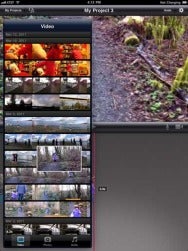
When working in portrait orientation, source video appears in a popover.
Clips that appear in your project are marked with an orange bar, so you can see which sections you’ve already used. Editing clips in the timeline is simple, and as intuitive as you can expect a video editor to be: When you tap a clip, those bright yellow selection handle orbs appear, begging to be dragged.
What’s not as intuitive is adding a title, where you need to double-tap a clip and choose a title style from the popover that appears. This is consistent from the previous version of iMovie for iOS, and once you’re familiar with the mechanism, it’s not a big deal. (This would be a good opportunity to point to iMovie’s new well-organized help system, accessible by tapping a question mark [?] icon on the main screen.)
When you need to make more specific edits, pinch outward vertically on a transition icon to open the Precision Editor. This takes advantage of the screen real estate to show both video clips around the transition and view the unused footage of each, helping you choose more deliberate edit points.
As soon as I started putting together a longer project, I noticed that swiping across the length of the timeline was time-consuming and less than ideal. However, Apple has a couple of solutions: Pinch with two fingers horizontally on the timeline to expand or contract its width, or—the behavior that’s now become second-nature to me—tap and hold the left or right end of the timeline just above the video clips to jump to the beginning or end.
Editing audio
The audio tools at your disposal have broadened in this version, which is a relief. It’s now possible to view audio waveforms for video and audio clips, making it easier to determine edit points.
iMovie for iOS now offers multiple audio tracks: One for the video track, one background music track, and three foreground audio tracks; a limited library of sound effects are also available. It’s now possible to include multiple background songs, versus having to choose just one, by turning off the Loop Background Music option in the Project Settings.
However, as welcome as these features are, I’m still left longing for more control. When you trim an audio clip, there’s no way to fade out the edit point, leaving an abrupt ending if you trimmed mid-sound. You can adjust only the overall volume of a clip. The background music track is also automatically ducked (made softer) when there’s audio in a video clip, but no control is available to enable, disable, or adjust the level of ducking.
Also, iMovie makes an assumption that any audio track under one minute in length should be foreground audio, not a background music track. That can be a problem if you want to open a video with a short piece of music from your iTunes music library, and then follow with a longer piece. iMovie places the short piece as a sound effect (a blue track beneath the video); when you add the next song, it appears as a background track, which locks to the beginning of the movie. Unlike the behavior in the desktop version of iMovie, you can’t pin a background track arbitrarily.
iPhone 4 and iPod touch
When Apple announced iMovie 1.2, I was especially curious to see how it translated to the iPhone and iPod touch. To my relief, Apple didn’t cram the new interface onto the small screen, even if it’s a high-resolution Retina display. It retains the minimal interface used in the first version of iMovie. The small-screen version doesn’t offer the Precision Editor or audio waveforms, but otherwise, you get a similar editing experience as on the iPad. The Video pane appears as a separate screen instead of tucked in the corner, but you can tap to select a clip and adjust its selection handles before adding it to the timeline. Dragging your finger along a clip brings up a preview thumbnail. And background audio clips appear as a green bar at the bottom of the timeline, instead of as a green field behind the other clips.
Sharing your movie
In the previous version of iMovie, you needed to send a finished movie back to the device’s Camera Roll before exporting it. Now, you can export the movie directly to YouTube, Facebook, Vimeo, and CNN iReport, as well as to the iPad’s Camera Roll. (It’s odd that MobileMe isn’t on that list; Apple pointed out to me that uploading to MobileMe is available via the Camera Roll, which means you need to go to the Photos or Camera apps to access it.) HD-quality options are offered for each of them, which is good if you have the bandwidth to send 720p files.
Of course, you don’t need to send your movie across the Internet to view it outside the iPad. iMovie supports playing a movie on devices like the Apple TV that support AirPlay. When you start playing full-screen and tap the AirPlay icon, iMovie creates an AirPlay-compatible version that appears to be 720p resolution. (In fact, I noticed the typical full-screen playback on the iPad itself was sometimes slightly lower resolution, presumably to play the movie in real time without rendering.)
Another option enabled by the iPad 2 is direct playback to an HDTV or projector via HDMI, using Apple’s Digital AV Adapter. When connected, the TV mirrors what’s on the iPad. However, I was surprised to discover that tapping the Play Full Screen button on the Projects page does not use the entire television the way playing a movie from the Videos app does. Instead, you get what’s mirrored on the screen: widescreen playback limited to the resolution of the iPad’s screen with bars at top and bottom. To get the full screen effect, you need to first share the movie to the Camera Roll, and play it there.
One other item in the sharing list is Send Project to iTunes. The idea is to be able to export an editable version of your project, for sharing with other iOS devices running iMovie or for creating a backup (other than the backup that’s automatically made when you sync your iPad). It’s the same mechanism used for transferring documents between the iPad and the computer, only in this case, alas, you can’t open the project iniMovie ‘11 on the Mac.
I hoped that I could use the feature to transfer a project directly from my iPhone to the iPad using a sync cable and Apple’s Camera Connection Kit USB adapter—that’s one way to transfer source movies and photos between devices. But Send Project to iTunes really means iTunes on the desktop: The feature makes a copy of your project (including the entirety of the source video files used, even if you’ve included just a few seconds of each in the movie itself) and stores it on the device; the next time you sync, it becomes available in the Apps pane of iTunes when the iPad is selected in the sidebar. From there you must save the file to somewhere on your computer, connect your destination iOS device, and add the project file to the File Sharing section in the same Apps pane. Then, finally, open iTunes on the device, go to the Projects screen, and tap the Import button.

Even after you’ve transferred a project to another device, you need to copy it into iMovie.
The process works, but it’s cumbersome. If you do some editing and want to send the project back to the original device, you must perform all of those steps again, plus be willing to put up with duplicate source clips (because the incoming project now includes all that footage, too). Fortunately, I don’t foresee many people going to all that trouble.
Little annoyances
Having more options in this version of iMovie is spoiling me, because I find myself wanting more—and reminding myself that iMovie was created as an app for mobile devices.
For example, Apple doesn’t even try to support the variety of video formats that people are likely to be shooting in. Footage is assumed to come from the iPad’s cameras, an iPhone 4, or a fourth-generation iPod touch (H.264 up to 720p, MPEG-4). AVCHD? Go to the desktop. Based on the video-capture devices at hand, I was able to import and edit footage from a Flip Mino HD, but not a Canon Powershot G12.
Now that iMovie supports multiple audio tracks, I would like to see the capability to extract audio from a video clip, so I could intercut scenes or perform a cutaway shot while the video clip’s audio continues to play.
Going back to the projects screen, the movie you were just working on isn’t selected. So if you want to play that movie full-screen, or share it to a video service, you must scroll to locate it again in the list.
Lastly, accessing songs and photos needs finer organization. If you sync photos from iPhoto, for example, events, albums, smart albums, and Faces are tossed into one long alphabetical list. And the Audio pane, particularly the Songs list, really needs the same sort of letter shortcut control that runs alongside the Contacts list in the FaceTime app for jumping through the library.
Macworld's buying advice
Apple's iMovie for iOS 1.2 is a friendly, easy-to-use app for the iPad 2 and the iPhone 4 and fourth-generation iPod touch. It makes great use of the iPad 2’s large screen, lets you add portions of clips to the timeline, gives you five audio tracks along with multiple background audio clips, while its Precision Editor aids in editing cut points. This new version reinforces the value of an app that was already fun to use and capable enough to turn casual video clips into movies you want to share far and wide.
Some of its shortcomings, such as the inability to gracefully fade audio clips and a clunky method of moving projects between iOS devices, prompt that same sense of longing I had with the first version of iMovie for iOS. Now that the app is available on the iPad (though sadly only for the new tablet) and brings the same added functionality to the iPhone and iPod touch, it makes me want more. However, priced at $5 (free if you purchased the original version), iMovie for iOS 1.2 is a great bargain.

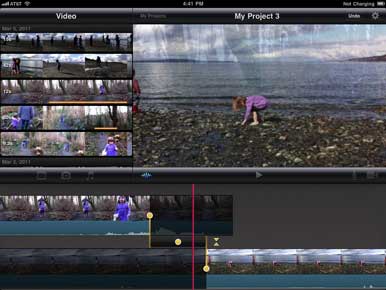
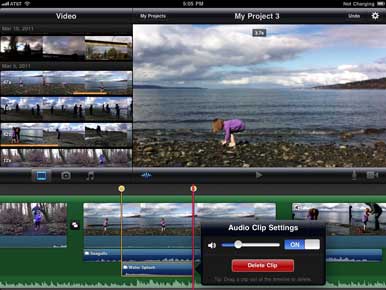
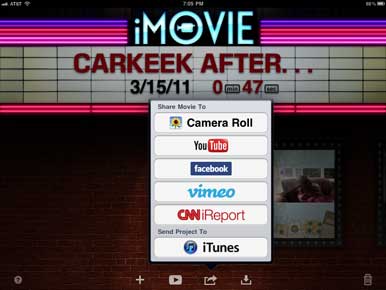
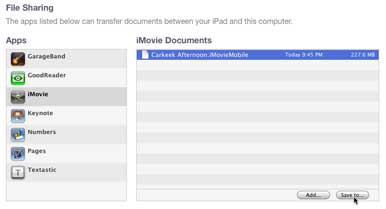
No comments:
Post a Comment